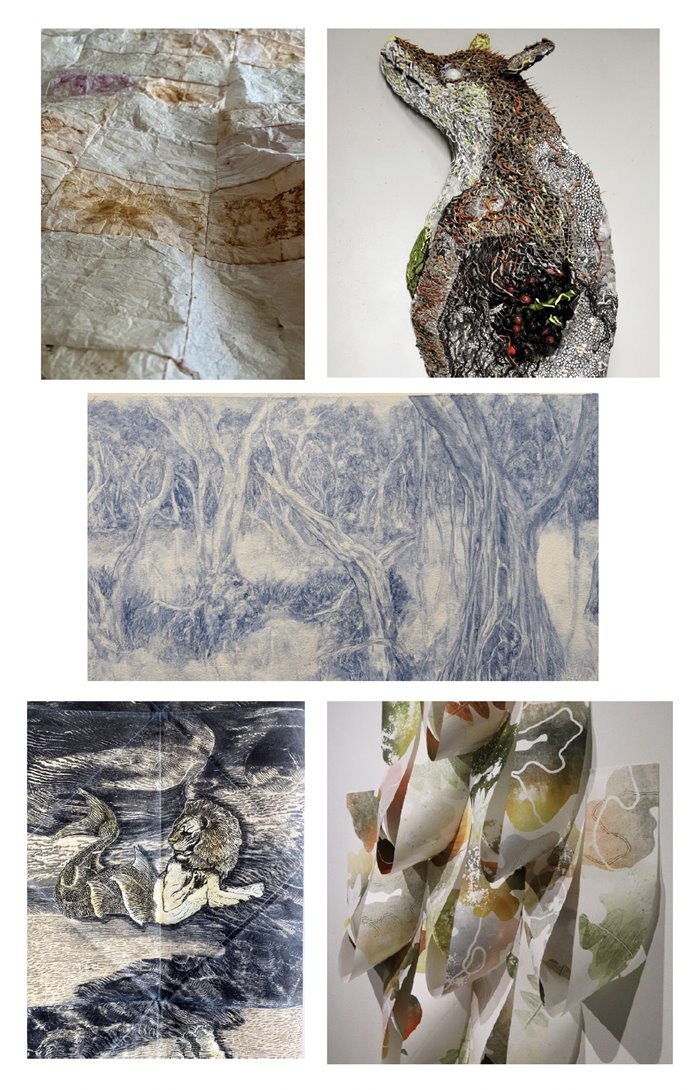
Paper Trails Between Lion and Swan
Curatorial statement
Paper Trails Between Lion and Swan (or Paper Trails for short) at ‘SCULPTURE 2052’ art gallery is the first of a two-phase curated exhibition featuring 12 artists working with paper and textiles, 6 from Singapore and 6 from Australia. Phase one of the exhibition will be at Singapore gallery SCULPTURE 2052 as part of ‘Singapore art Week’ (SAW) in January 2024, with phase two featured at ‘Old Customs House’ in June 2024. Singapore artists include Ezzam Rahman, Nhawful Juma’at, Tan Yen Peng, Terry Wee, Xin Xiao Chang and Yeo Chee Kiong. Australian artists include Deborah Worthy-Collins, Desmond Mah, Di Cubitt, Harrison See, Kelsey Ashe and Sarah Thornton-Smith.
We begin our co-authored curatorial statement by respectfully acknowledging the Aboriginal and Torres Strait Islander peoples as the traditional custodians of Australia. Specifically, we acknowledge the Noongar people as the traditional custodians of the unceded land on which Perth was colonised, and pay respect to the Noongar people’s enduring culture of tens of thousands of years and the leadership of their elders past and present. Lastly, we recognise ‘Boorloo’ as the Noongar name for the Perth region and will use ‘Perth/Boorloo’ in our statement.
At a glance, Singapore and Perth/Boorloo appear to be categorically different cities: the former (population ≈ 6 million) is the densely populated gateway between the Global North and South, and the latter (population ≈ 2 million) is one of the most isolated major cities in the world. However, there are significant similarities, more than just a shared time zone. The two histories of these coastal and culturally diverse port cities are intersected by British colonisation. Perth/Boorloo was colonised as the ‘Swan River Settlement’ in 1829, while Singapore was claimed as a port for Britain’s East India Company in 1819—‘Singapore’ the anglicisation of ‘Singapura’, which was derived from the Sanskrit word for ‘Lion city’ (or ‘Lion fortress’); whereas Perth was named after the Scottish town where British settler leaders had connections and the river after the black swans unique to the colony.
Within an Asia-Pacific context, attempts to renegotiate colonial histories are complex. Even when adopting the term ‘Perth/Boorloo’ out of acknowledgement and respect, it potentially reinscribes not only a hierarchy of English over Noongar, but a binary of coloniser/colonised. Further, these dualistic terms potentially exclude non-European cultural communities from Australia’s colonial histories. The regrettable legacy of the White Australia Policy notwithstanding, records reveal that as early as 1818—a year before the Swan River Settlement was colonised on the west coast—a man from Guangzhou immigrated to Australia’s east coast1, which begs the question, how might Asian diaspora fit into Australia’s attempts at reconciling its colonial history? More recently, it is evident by the Trumpian Sinophobic sentiment during COVID-19, that in times of crises it is too easy to resort to the problematic simplicity of ‘us’ vs ‘them’ thinking, and a tendency to reinscribe binaries of opposition like East-vs-West that neglect the nuance of forward-thinking contemporary cultural exchange.
In 2024, as we approach the midpoint between the 200-years since Perth/Boorloo and Singapore’s aforementioned encounters with British imperialism—2019 and 2029 respectfully—an opportunity presents itself to negotiate new intersections between these cities of Lion and Swan. Further, the choice of materials for Paper trails is intentional and symbolic. Paper was used by the British Empire to invoke deeds, certificates, propaganda, and letters as instruments of identity, division, authority and ownership. Textiles were used for flags, banners and uniforms, as well as the sails of ships that facilitated the expansion of trade, influence and military conquest. There is a sense of irony in using these symbolically-loaded materials to think beyond a postcolonial present; however, as artists know, it is through the handling of materials that new and unfamiliar meanings can be inscribed to old and familiar ways of knowing and being. The exhibition does not intend to condemn nor celebrate the British colonialism, its feats and injustices are deeply woven into the Asia-Pacific region. Rather, Paper trails is an invitation for the artists and their audience to question and imagine new ways of approaching the challenges and opportunities of cultural hybridity, transnationalism and multiculturalism.
We conclude by thanking SCULPTURE 2052 for their support during the Singapore phase of the Paper Trails exhibition and look forward to the second phase of Paper Trails when its artists come to Perth/Boorloo with the support of Artsource. Lastly, we thank the Department of Local government, Sport and Cultural Industries (DLGSC) of the Government of Western Australia for their funding and support.
Harrison See, Desmond Mah and Yeo Chee Kiong
Co-curators of Paper Trails Between Lion and Swan
Sahni, N. (2017). Mak Sai Ying aka John Shying. The City of Parramatta Council’s Research and Collection Services. https://historyandheritage.cityofparramatta.nsw.gov.au/people/mak-sai-ying-aka-john-shying
artwork details
Deborah Worthy-Collins (2023), Laphet/to receive with one hand. Teabags, thread, and cotton. Dimensions Variable.
Desmond Mah (2023), The road-kill I saw leaving Koorabup (Denmark, Western Australia) and later in my mind. Acrylic paint, mixed media, print, xuan paper, bamboo. 16cm (H) x 86cm (W) x 40 cm (D).
Di Cubitt (2023), Remnants and Ghosts. Oil on paper, 36cm (H) x 106cm (W).
Kelsey Ashe (2023), Orihon Codex of the Flame, Shell, Swan and Mer-Lion. Canvas, paper and Silk, botanical inks Indigo, Myrolaban, Wax; Screen Printed Origami Folding Concertina Scroll. 140cm (H) x 300cm (W) x 0.2cm (D) [when open] and 30cm (H) x 70cm (W) x 35cm (D) [when closed].
Sarah Thornton-Smith (2023), Heartlines. Etching inks on hosho paper. Dimensions variable.
Artsource Residency Programme : 1 - 30 June 2024
Exhibition opening at Old Customs House : 8 June 2024
Exhibition runs : 9 - 23 June 2024